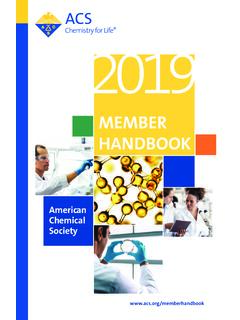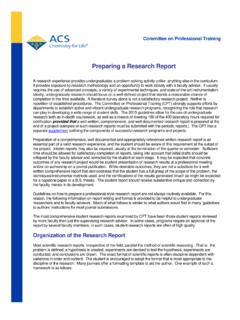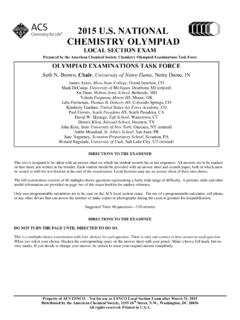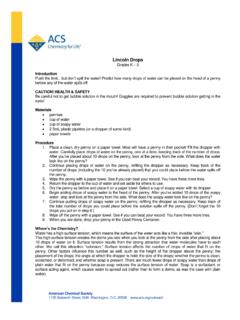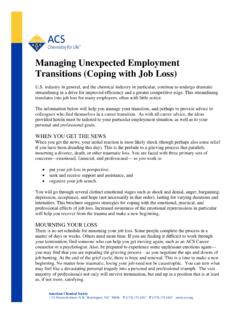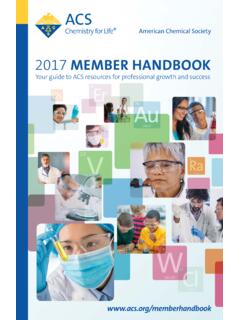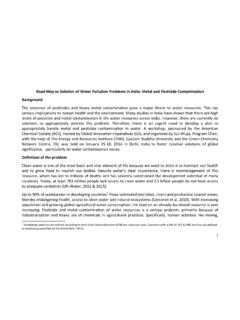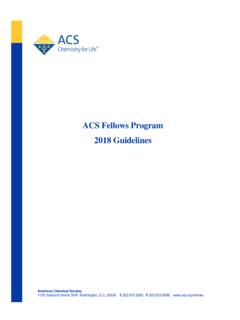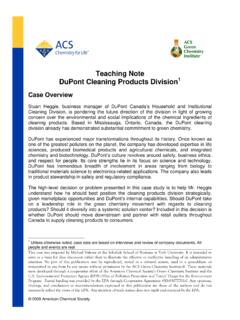Transcription of What is a Chemical Weapon? - American Chemical Society
1 ORGANISATION FOR THEPROHIBITION OF Chemical WEAPONSFACTSHEET4 Working together for a world free of Chemical weaponsWhat is a Chemical Weapon? All States Parties to the Chemical weapons Convention (CWC) commit to a world free of Chemical weapons . Key to this commitment and the implementation of the Convention is the way in which Chemical weapons are defined. In order to be as compehensve as possible, this definition encompasses fully developed Chemical weapons , the components of such weapons when stored separately ( binary munitions), chemicals used to produce Chemical weapons (precursors), and, under the general purpose criterion, items with a civilian use when intended for Chemical weapons (dual-use items).
2 The definition also includes munitions and devices intended for the delivery of toxic chemicals and equipment directly in connection with those munitions and weapons under the CWCA common conception of a Chemical weapon is of a toxic Chemical contained in a delivery system such as a bomb or artillery shell. While technically correct, a definition based on this conception would only cover a small portion of the range of things the CWC prohibits as Chemical weapons . For one thing, CW components a toxic Chemical and delivery system, for ex-ample may be stored separately, each in and of itself less than a fully developed weapon.
3 In the case of binary munitions, a non-lethal Chemical may actually be stored within a muni-tion, only to be mixed with a second Chemical inserted into the muni-tion shortly before firing, and the toxic product disseminated upon ar-rival at the complexity of the Chemical weapon defi-nition needed to meet the objectives of the Convention can be seen when considering dual use items and technolo-gies. Dual-use chemi-cals are those that can be used for peaceful and commercial purposes and can also be used as, or applied to the creation of, chemi-cal weapons .
4 To address the potential threat posed by these chemicals, the CWC definition of a Chemical weapon had to be as comprehensive as the same time, however, care had to be taken not to define Chemical weapons in a way that unnecessarily hindered legitimate uses of chemicals and the economic and technological development to which such uses may lead. While providing for the prevention of production or stockpiling of Chemical weapons , the definition could not result in restrictions of any State Party s right to to produce and use chemicals for peaceful purposes or to acquire and retain con-ventional weapons and their associated delivery systems.
5 The definition eventually adopted allowed for a balanced approach under which the Convention s objec-tives can be met while the rights of States Par-ties are preclude contra-vention of the treaty s intent by separation of Chemical weapons into component parts, the Convention defines each component of a Chemical weapon (CW) as a Chemical weapon whether as-sembled or not, stored together or separately. Anything specifically designed or intended for use in direct connection with the release of a Chemical agent to cause death or harm is itself a Chemical weapon.
6 Specifically, the definition is divided into three parts: toxic chemicals and their precursors, munitions or devices and equipment directly in connection with munitions and of the soman conjugate of acetylcholinesterase. Nerve agents like soman inhibit the normal actions of acetylcholinesterase, an enzyme crucial to nervous systems (Protein Data Bank Structure 2 WFZ)Types of Chemical WeaponsThe first part of the definition states that all toxic chemi-cals and their precursors, except when used for pur-poses permitted by the CWC in specified quantities, are Chemical weapons .
7 Toxic chemicals are defined as any Chemical which through its Chemical action on life processes can cause death, temporary incapacitation or permanent harm to humans or animals . Precursors are chemicals involved in production stages for toxic chemicals. Except for very limited application for pro-tection programmes, medical research or other permit-ted purposes, the production of some toxic chemicals with virtually no legitimate peaceful uses, such as sarin (GB), is banned. Determining whether genuinely dual-use chemicals are Chemical weapons is more difficult.
8 For example, chemicals such as chlorine, phosgene and hydrogen cyanide (AC) all of which were used during World War I as Chemical weapons are also key ingredients in numerous commercial products. To make the determination, toxic dual-use chemicals are subjected to the so-called general purpose to the general purpose criterion, a toxic or precursor Chemical may be defined as a Chemical weapon depending on its intended purpose. Put simply, a toxic or precursor Chemical is defined as a Chemical weapon unless it has been developed, produced, stockpiled or used for purposes not prohibited by the Convention.
9 The definition thus includes any Chemical intended for Chemical weapons purposes, regardless of whether it is specifically listed in the Convention, its Annexes or the three schedules of chemicals (see Fact Sheet 7). The CWC does not, however, expressly state what Chemical weapons purposes are. Instead, it lists those purposes that are not prohibited by the Convention. Hence, chemicals intended for purposes other than these are considered Chemical basic component of the general purpose criterion is the principle of consistency. A toxic Chemical held by a State Party and in agreement with this principle will not only be produced, stockpiled or used for a le-gitimate purpose, but also will be of a type and quantity appropriate for that second part of the Convention s definition of a Chemical weapon includes any munitions or devices specifically designed to inflict harm or cause death through the release of toxic chemicals.
10 Among these could be mortars, artillery shells, missiles, bombs, mines or spray tanks. In order to be defined as a chemi-cal weapon, however, the items in question would have had to have been designed and built with the intent to release any of the toxic chemicals in the first part of the and lastly, any equipment specifically designed for use directly in connection with employment of the munitions and devices of the second part of the defini-tion are identified as Chemical weapons . As with the second part, the principle of specificity applies.
